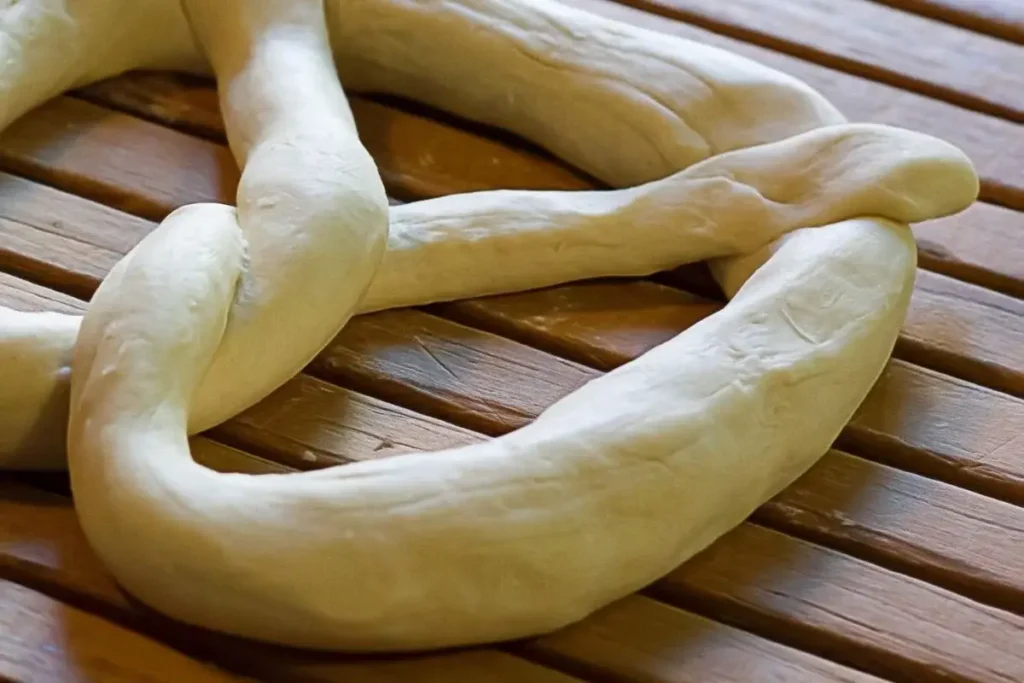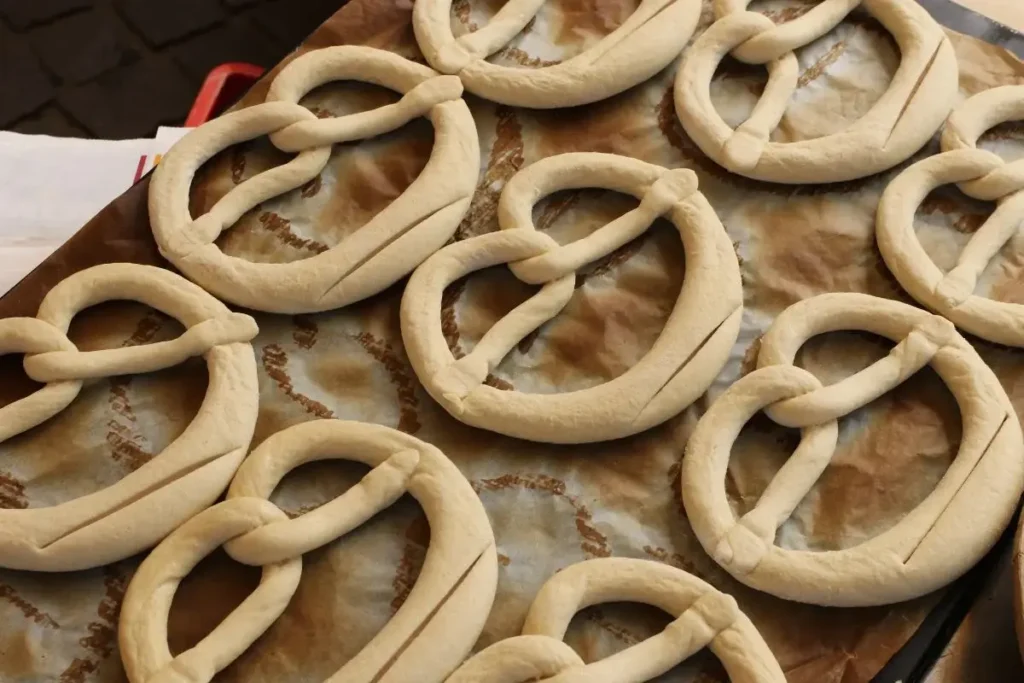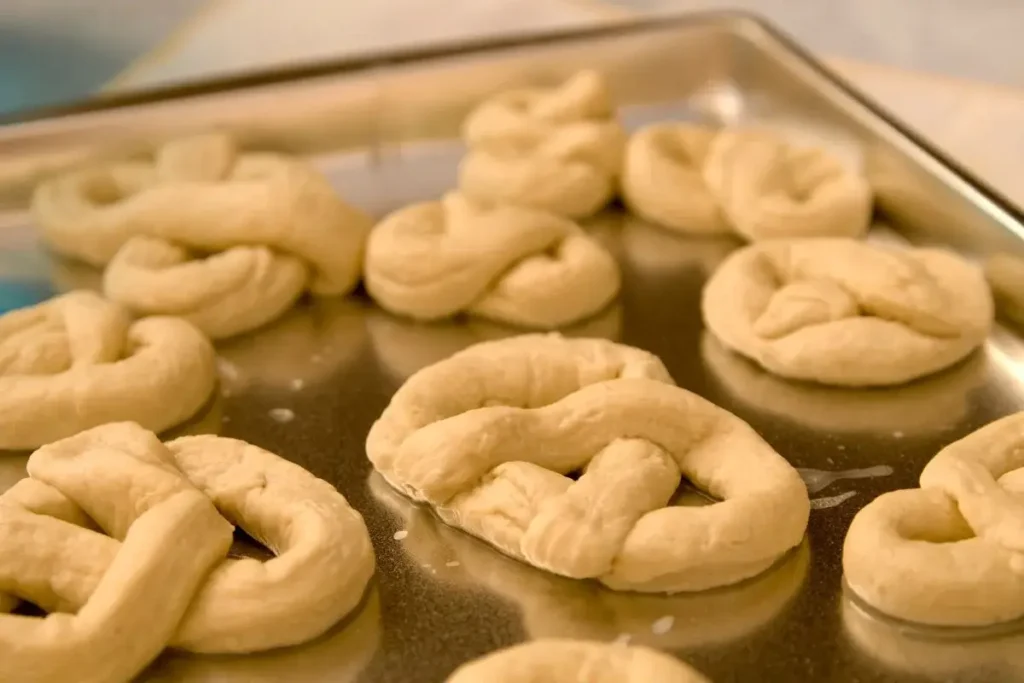
How to Store Pretzel Dough Overnight in 5 Simple Ways
Pretzel dough, with its unique chewy texture and delightful flavor, is a culinary delight. Whether you’re a seasoned baker or a novice in the kitchen, the process of storing pretzel dough overnight can significantly impact the final result.
In this comprehensive guide, we’ll explore 5 simple ways to store pretzel dough overnight, ensuring your baking endeavors are met with success.
Table of Contents
ToggleWhy Store Pretzel Dough Overnight?
Letting pretzel dough store overnight is a key step to getting that awesome flavor, texture, and look we all love in these twisted treats. This simple trick adds a lot of character to the dough, making the final pretzels way better than if you rush the prep.
One big reason for storing pretzel dough overnight is the fermentation process. Giving the dough plenty of time lets the yeast do its thing, breaking down sugars and making carbon dioxide.
This natural fermentation not only boosts the dough’s flavor with subtle, fancy notes but also makes it light and fluffy. The overnight rest helps the gluten in the dough chill out and develop, giving you pretzels that are perfectly chewy and tender.
Plus, letting the dough sit for a while creates cool byproducts like organic acids and alcohols. These guys help give the pretzels that awesome crust, making a tasty contrast with the soft inside. The overnight rest also kicks the Maillard reaction into high gear during baking, giving you those golden-brown pretzels with an extra burst of flavor.
And it’s not just about taste and texture – letting the dough hang out overnight makes baking way easier. Getting the dough ready ahead of time means you can be more flexible with your schedule. This is especially handy for professional kitchens or home bakers with a lot on their plate.
Can I Put Pretzel Dough in the Fridge Overnight?
Freezing your pretzel dough in the fridge overnight is a great move. It not only makes prepping easy but also amps up the flavor and texture of your pretzels.
The cool fridge vibe slows down the dough’s fermentation, giving it a tastier kick while keeping that awesome chewiness intact. To nail this method, make sure your pretzel dough is snugly wrapped in plastic or snug in an airtight container.
This shield stops the dough from drying out and keeps it top-notch. When it’s time to bake, just grab the dough, let it warm up a bit, and then get down to shaping and baking. Overnight chilling is a game-changer for busy bakers aiming for tasty results.

How to Store Pretzel Dough Overnight in 5 Simple Methods
In this section, we’ll explore my five simple methods to ensure your pretzel dough is perfectly stored, allowing for a stress-free baking experience.
Method 1: Plastic Wrap
One of the easiest and most effective ways to store pretzel dough overnight is by using plastic wrap. This method ensures the dough remains moist and prevents it from drying out. After preparing your pretzel dough, shape it into the desired form and cover it completely with plastic wrap.
Ensure there are no gaps for air to seep through, as this will maintain the dough’s moisture content. This technique not only simplifies the storage process but also enhances the dough’s flavor as it rests overnight.
Method 2: Ziplock Bags
Ziplock bags offer a convenient and airtight solution for storing pretzel dough. Once your dough is prepared, place it inside a Ziplock bag, removing as much air as possible before sealing.
The airtight environment created by the bag preserves the freshness of the dough and allows for easy retrieval when you’re ready to bake. This method is particularly beneficial for those with limited space, as it can easily fit into crowded refrigerators.
Method 3: Parchment Paper
For a straightforward yet effective approach, consider using parchment paper to store your pretzel dough overnight. After shaping the dough, wrap it securely in parchment paper, ensuring all sides are covered.
This method offers a balance between moisture retention and breathability, preventing the dough from becoming too damp or dry. Parchment paper also simplifies the process of transferring the dough to your baking surface when you’re ready to craft your pretzels.
Method 4: Airtight Containers
Airtight containers provide a foolproof way to keep your pretzel dough in optimal condition. Choose a container that comfortably accommodates the size of your dough, ensuring a snug fit.
The airtight seal safeguards the dough from external elements, maintaining its moisture and preventing unwanted odors from affecting its taste. This method is particularly advantageous if you plan to store multiple batches or if fridge space is at a premium.
Method 5: Refrigeration
Refrigerating pretzel dough is a versatile method that allows for longer storage while preserving the dough’s quality. After shaping the dough, place it in the refrigerator. The cool environment slows down the fermentation process, contributing to a more developed flavor.
When ready to bake, allow the dough to come to room temperature for a brief period to ensure optimal results. Refrigeration is an excellent option for those who want to plan ahead or extend the storage beyond a single night.

What if My Pretzel Dough Rises Too Much Overnight?
Encountering overly risen pretzel dough can be a bit disheartening, but fear not—there are effective ways to address this situation. Overproofing, characterized by excessive fermentation, can lead to a lack of structure and compromised texture in your pretzels. If you find yourself in this predicament, consider the following solutions to salvage your dough.
Identifying Overproofing: Determining whether your dough has risen too much is crucial. Look for signs such as a flattened appearance, a pungent alcohol smell, or an overly sticky texture. These indicators suggest that the dough has fermented beyond the ideal point.
Remedies for Overproofed Pretzel Dough:
- Refrigeration Rescue: Place the overproofed dough in the refrigerator for a short period. The cooler environment slows down fermentation, giving you a window to regain control over the rise.
- Kneading Intervention: Gently knead the dough to expel excess gas. This redistributes the yeast and can restore some structure to the dough. Be cautious not to over-knead, as this may further impact the texture.
- Divide and Conquer: If the entire batch is overproofed, consider dividing it. This can help redistribute the yeast and mitigate the effects of overfermentation.
- Shortened Baking Time: Adjust your baking time to prevent further expansion. Keep a close eye on your pretzels in the oven and remove them once they reach the desired color and texture.
Preventative Measures: To avoid overproofing in the future, monitor the fermentation process closely. Adjust the storage time based on ambient temperature, and always follow recommended guidelines for the specific storage method you choose.
How Long Can Pretzel Dough Sit Out?
The duration pretzel dough can sit out depends on several factors, primarily the room temperature and the dough’s composition. As a general rule, it is advisable to allow the dough to rest at room temperature for around 30 minutes to an hour after preparation. This short resting period contributes to the dough’s rise and allows the yeast to work its magic.
However, leaving pretzel dough at room temperature for an extended period may lead to overfermentation, resulting in undesirable changes in texture and taste. If the room is exceptionally warm, it’s crucial to monitor the dough closely to prevent overproofing. In warmer conditions, consider reducing the resting time to maintain control over the fermentation process.
For longer storage, it is recommended to follow one of the outlined overnight storage methods, such as using plastic wrap, Ziplock bags, parchment paper, airtight containers, or refrigeration. These methods provide a controlled environment, preserving the dough’s quality while allowing for more extended preparation times.

What Happens If I Let Pretzel Dough Rise Too Long?
Allowing pretzel dough to rise excessively can lead to undesirable outcomes, affecting both flavor and texture. Overproofing, as it’s commonly known, occurs when the dough ferments for an extended period beyond what’s necessary.
The consequences of letting pretzel dough rise too long include a loss of structure and a compromised texture. The dough becomes overly airy, resulting in a final product that lacks the characteristic chewiness associated with pretzels.
Overproofed pretzel dough may also exhibit a weakened gluten structure, leading to a flatter appearance and a less appealing mouthfeel. The excessive fermentation can contribute to a sour taste, overpowering the intended flavor profile of the pretzels. To avoid these pitfalls, it’s crucial to monitor the dough during the rising process, especially when storing it overnight.
By adhering to recommended rising times and promptly moving to the next baking steps, you can ensure your pretzel dough achieves the perfect balance of rise and texture, resulting in a delightful culinary experience.
How to Store Pretzel Dough Overnight | Final Thoughts
In conclusion, making pretzels becomes something special when you discover the trick of letting the dough store overnight. It goes beyond just being convenient – this cooking magic boosts both the taste and texture, transforming your baking into a flavorful symphony.
Whether you go for the simplicity of plastic wrap, the easy Ziplock bags, the reliable parchment paper, the foolproof airtight containers, or the flexibility of using the fridge, each method ensures a hassle-free baking experience.
And if your dough rises too much at times, don’t worry – refrigeration, gentle kneading, and keeping a close eye in the oven can rescue your pretzels and keep them perfect. Happy baking!
Lindsey Mackenzie
About me
Hi there! I’m Lindsey Mackenzie, the founder of Bake Smartly. Baking has been my passion since childhood, growing up in my father’s bakery. With Bake Smartly, I’m excited to share my love for all things sweet and savory. Join me on this delicious journey as we whip up scrumptious treats and sprinkle joy into every bite!






